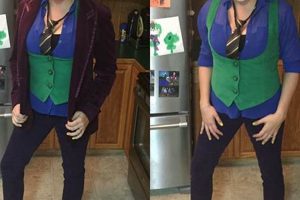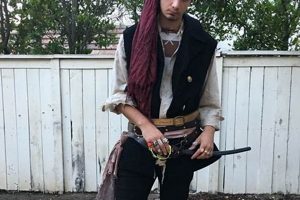The subject involves the creation of homemade outfits inspired by the characters Thing One and Thing Two from Dr. Seuss’s The Cat in the Hat. These typically consist of red jumpsuits or shirts, coupled with a blue wig for each character. A common example involves individuals crafting these outfits using readily available materials such as felt, fabric paint, and inexpensive wigs.
Constructing these themed outfits offers a cost-effective alternative to purchasing pre-made costumes, particularly for group events or family ensembles. The activity promotes creativity and resourcefulness, allowing for personalization and adaptation to individual preferences. The origin of these costumes is directly linked to the enduring popularity of the source material and its recognizable characters.
Subsequent sections will delve into specific methods for creating these outfits, detailing material selection, construction techniques, and customization options. Considerations for comfort, durability, and safety will also be addressed, ensuring a successful and enjoyable costume-making experience.
Tips for Crafting Thing One and Thing Two Attire
This section provides practical guidance for constructing homemade costumes inspired by the characters Thing One and Thing Two. Attention to detail and material selection is paramount for achieving a satisfactory outcome.
Tip 1: Fabric Selection: Opt for a durable, breathable red fabric such as fleece or felt. These materials offer ease of handling and minimize fraying during construction.
Tip 2: Wig Acquisition: Procure quality blue wigs that can withstand styling. Consider synthetic fibers that resist tangling and maintain their shape throughout wear.
Tip 3: Embellishment Adherence: Secure the white circular patches, bearing the numbers “1” and “2,” with a robust adhesive. Fabric glue or iron-on adhesive sheets provide lasting results.
Tip 4: Pattern Utilization: Employ pre-existing jumpsuit or tunic patterns to ensure proper fit and symmetrical construction. Adjustments can be made to accommodate individual measurements.
Tip 5: Seam Reinforcement: Reinforce all seams with a durable stitch to prevent ripping or tearing, particularly in areas subjected to stress during movement.
Tip 6: Comfort Considerations: Prioritize wearer comfort by selecting soft, non-irritating materials and avoiding restrictive designs. Ample room for movement should be maintained.
Tip 7: Wig Styling Techniques: Employ styling products sparingly to maintain the integrity of the wig fibers. Avoid excessive heat styling to prevent damage.
Adhering to these guidelines promotes the creation of costumes that are both visually appealing and structurally sound. Careful planning and execution will contribute to a successful outcome.
The following sections will explore advanced customization techniques and address common troubleshooting scenarios encountered during the construction process.
1. Fabric suitability
Fabric suitability constitutes a critical determinant in the successful realization of homemade character-inspired attire. Material selection directly impacts the aesthetic appeal, durability, and overall comfort of the finished product. The following details elaborate on key facets of appropriate fabric choices.
- Material Durability and Longevity
The selected fabric must withstand regular wear and potential stress. Fabrics such as fleece or felt, while visually appropriate, exhibit varying degrees of durability. For costumes intended for repeated use, a tightly woven, more resilient material is preferable to minimize wear and tear. Selecting a material with enhanced durability reduces the likelihood of seam failure and maintains the costume’s structural integrity over time.
- Colorfastness and Dye Stability
The fabric’s ability to retain its color through washing and wear is essential, particularly with the characteristic bright red associated with the theme. Poor colorfastness leads to fading and discoloration, diminishing the visual impact of the costume. Pre-washing the fabric can mitigate potential dye bleeding or fading issues. Selecting fabrics with high colorfastness ratings ensures the costume maintains its vibrancy over time.
- Texture and Visual Representation
The texture of the fabric contributes to the overall visual resemblance to the source material. A smooth, non-reflective fabric aligns more closely with the intended aesthetic. Consider the drape and hand of the fabric; stiffer fabrics create a more structured silhouette, while softer fabrics offer a more fluid appearance. Balancing visual accuracy with comfort and ease of construction is key.
- Ease of Handling and Construction
The chosen fabric should be manageable during the cutting, sewing, and embellishment processes. Fabrics that fray easily require additional finishing techniques to prevent unraveling. Elasticity can complicate sewing, especially for intricate details. Selecting a fabric that is easy to manipulate reduces construction time and minimizes potential errors.
These facets collectively influence the ultimate success of homemade renditions. Careful attention to fabric characteristics ensures that the finished costume not only captures the visual essence of the characters but also provides lasting wearability and minimizes construction challenges.
2. Wig styling
The meticulous presentation of the blue wigs is an indispensable element in achieving a faithful representation of Thing One and Thing Two when creating homemade outfits. The wig’s style significantly impacts the overall recognizability and visual impact of the costume.
- Fiber Management and Volume Creation
Achieving the characteristic voluminous, somewhat unruly hairstyle requires careful manipulation of the wig’s fibers. Backcombing, teasing, and the strategic application of hairspray contribute to the desired effect. Neglecting proper fiber management results in a flat, lifeless wig that detracts from the overall costume. For example, sectioning the wig and applying hairspray in layers helps build volume without creating excessive stiffness.
- Shape Maintenance and Styling Product Selection
The wig’s shape must be maintained throughout wear to preserve its visual integrity. This necessitates the use of appropriate styling products, such as hairspray, gel, or mousse, that provide hold without compromising the wig’s texture. Overuse of styling products can lead to stiffness and an unnatural appearance. Consider selecting products specifically formulated for synthetic fibers to prevent damage or discoloration.
- Color Ac
curacy and Shade MatchingThe blue hue of the wig must closely match the intended shade to ensure visual consistency with the character design. Discrepancies in color can detract from the costume’s authenticity. Comparing the wig’s color to reference images of Thing One and Thing Two is crucial. If necessary, wig dye or spray can be used to adjust the color, though this should be done with caution to avoid uneven application or fiber damage.
- Secure Attachment and Wearer Comfort
The wig must be securely attached to the wearer’s head to prevent slippage or dislodgement during wear. Wig caps or combs can be used to enhance stability. Consider the wearer’s comfort when selecting attachment methods, as prolonged wear can cause discomfort or irritation. Adjusting the wig’s fit and using breathable wig caps can improve comfort.
These considerations for wig styling are integral to realizing an authentic and visually compelling presentation. Attending to these details elevates the final product, contributing significantly to the overall success of the homemade interpretation.
3. Adhesive strength
The efficacy of any homemade ensemble relies significantly on the robustness of the adhesive materials employed. In the specific context of crafting attire inspired by Thing One and Thing Two, adhesive strength is paramount for securing embellishments and ensuring the structural integrity of the costume, thereby impacting its longevity and visual appeal.
- Secure Attachment of Numerical Appliqus
The prominent numerical designations, “1” and “2,” affixed to the costumes, typically require robust adhesive application. The bond must withstand movement and potential abrasion during wear. Weak adhesion results in detachment, compromising the costume’s recognizability. Fabric glue or iron-on adhesives with high bonding strength are suitable choices, requiring careful application to ensure complete surface contact.
- Fabric-to-Fabric Bonding Integrity
Construction frequently involves bonding fabric pieces together, such as attaching collars, cuffs, or reinforcing seams. The adhesive must maintain its integrity under stress and potential washing conditions. Failure results in seam separation or delamination, diminishing the costume’s overall appearance and durability. Selection of adhesives specifically formulated for fabric is crucial, along with proper application techniques to maximize bond strength.
- Wig Attachment and Accessory Fixation
Securing wigs or affixing accessories, such as bows or other decorative elements, often necessitates adhesive use. The adhesive must provide a reliable bond that prevents dislodgement during activity. Weak adhesion poses a safety risk and detracts from the costume’s aesthetic appeal. Cyanoacrylate adhesives (super glue) or specialized wig adhesives may be employed, depending on the materials involved, with careful consideration given to potential skin irritation.
- Prevention of Embellishment Detachment During Use
Beyond initial application, the long-term strength of adhesive bonds directly influences the costume’s durability during wear and potential cleaning. Exposure to environmental factors, such as humidity or temperature fluctuations, can weaken adhesive bonds over time. Thorough preparation of surfaces, selection of appropriate adhesives, and proper curing times are essential for maximizing bond longevity and minimizing the risk of detachment.
In summary, adhesive strength is an indispensable factor in the successful creation and prolonged usability of costumes. The selection of suitable adhesives, coupled with meticulous application techniques, contributes significantly to the overall quality and durability, thus ensuring the costume maintains its intended appearance throughout its use.
4. Pattern accuracy
Pattern accuracy is a foundational element in the creation of homemade attire inspired by the characters Thing One and Thing Two. Deviation from precise pattern specifications can compromise the costume’s visual fidelity and overall structural integrity, thereby diminishing its effectiveness.
- Sizing Consistency and Wearability
Accurate patterns ensure consistent sizing across all costume components, leading to a comfortable and wearable finished product. Inaccurate patterns result in ill-fitting garments that restrict movement or appear disproportionate. For instance, a sleeve pattern that is too short or a torso pattern that is too wide detracts from the costume’s aesthetic and functionality. Precise measurements and adherence to established sizing charts are essential.
- Symmetrical Alignment and Visual Fidelity
Symmetry is a key characteristic of the Thing One and Thing Two attire. Accurate patterns facilitate the creation of symmetrical garment pieces, such as identical sleeves or pant legs. Asymmetrical patterns result in a visually unbalanced costume that deviates from the intended design. Careful tracing, cutting, and alignment of pattern pieces are critical for achieving the desired symmetry.
- Seam Allowance Precision and Construction Integrity
Consistent seam allowances are crucial for accurate pattern execution and robust garment construction. Inconsistent seam allowances result in mismatched seams, puckering, or structural weaknesses. For example, a pattern with varying seam allowances along a curved edge makes it difficult to achieve a smooth, professional finish. Accurate pattern markings and consistent sewing practices are necessary for maintaining seam allowance precision.
- Proportional Representation and Character Recognition
Accurate patterns contribute to the proportional representation of garment features, ensuring that the finished costume closely resembles the characters’ iconic appearance. Disproportionate patterns result in a costume that appears distorted or fails to capture the essence of the characters. For example, an oversized collar or an inappropriately shaped tunic compromises the costume’s visual impact and recognizability. Careful pattern selection and adjustment are essential for achieving accurate proportional representation.
The integration of accurate patterns into the construction process is thus pivotal for achieving homemade renditions that not only replicate the visual attributes of the iconic characters but also provide a well-fitted, structurally sound, and visually compelling result. Attention to pattern detail directly translates into a higher quality and more satisfying final product.
5. Seam durability
Seam durability constitutes a critical factor in the creation and longevity of do-it-yourself costumes, particularly those inspired by the characters Thing One and Thing Two. The integrity of seams directly impacts the costume’s ability to withstand wear, movement, and potential stress, influencing its overall lifespan and aesthetic appeal.
- Thread Strength and Material Compatibility
The selection of appropriate thread is param
ount. Thread strength must correspond to the weight and weave of the fabric employed. Using a thread weaker than the fabric results in seam failure under minimal stress. For instance, attempting to sew heavy fleece with delicate thread in a Thing One costume will likely result in ripped seams during normal activity. Selecting thread specifically designed for the chosen fabric and employing appropriate tension settings on the sewing machine is crucial. - Stitch Type and Density
The chosen stitch type and its density per inch significantly impact seam durability. A straight stitch, while suitable for basic seams, lacks the elasticity and strength required for areas subject to stress. Zigzag stitches or reinforced straight stitches offer greater flexibility and resistance to tearing. Increasing stitch density strengthens the seam by distributing stress more evenly. In a Thing Two costume, reinforcing seams around armholes or the crotch with a denser zigzag stitch can prevent premature failure during active use.
- Seam Finishing Techniques
Raw edges of fabric are prone to fraying, which weakens the seam and compromises its appearance. Employing seam finishing techniques, such as serging, zig-zagging, or binding, prevents fraying and prolongs seam life. For example, serging the raw edges of the red fleece used in a Thing One costume ensures that the seams remain intact after repeated wear and washing, preventing the costume from looking worn or unfinished.
- Reinforcement of Stress Points
Certain areas of a costume, such as armholes, crotches, and closures, are subjected to higher levels of stress. Reinforcing these points with additional stitching, interfacing, or stay tape enhances their durability. A Thing Two costume might require reinforcing the area around a zipper or snap closure with interfacing to prevent the fabric from tearing under strain. This proactive measure significantly extends the costume’s lifespan.
By prioritizing appropriate thread selection, stitch type, seam finishing, and reinforcement of stress points, the durability of seams in homemade attire is substantially increased. This ultimately translates into a more resilient, visually appealing, and longer-lasting costume inspired by Thing One and Thing Two, thereby enhancing the overall crafting experience and the satisfaction derived from the finished product.
6. Wearer comfort
Wearer comfort is a paramount consideration in the creation of homemade attire, particularly in the context of costumes intended for extended wear or active use, such as those inspired by Thing One and Thing Two. The successful execution of these projects hinges not only on visual accuracy but also on the practical aspects of comfort and wearability.
- Material Selection and Skin Sensitivity
The selection of fabrics that minimize skin irritation is crucial. Synthetic materials, while often cost-effective, can cause discomfort or allergic reactions in some individuals. Natural fibers, such as cotton, offer enhanced breathability and reduced irritation. For instance, lining the inside of a Thing One costume with a soft cotton jersey can mitigate discomfort associated with prolonged wear against the skin. Considerations should extend to potential sensitivities to dyes or chemical treatments applied to fabrics.
- Seam Construction and Friction Reduction
Seam construction techniques significantly influence wearer comfort. Exposed or poorly finished seams can cause chafing and irritation, especially in areas of high friction, such as under the arms or around the legs. Employing flatlock seams or serging raw edges minimizes bulk and reduces the likelihood of chafing. Padding or strategically placed linings can further enhance comfort in areas prone to irritation. The strategic placement of seams can also mitigate discomfort.
- Fit and Range of Motion Considerations
A well-fitted costume allows for unrestricted movement and minimizes discomfort. Restrictive designs can impede breathing, circulation, and range of motion. Prioritizing ease of movement in the design process, such as incorporating gussets or elasticated panels, enhances wearer comfort. Accurate measurements and pattern adjustments are essential for achieving a comfortable fit. Overly tight costumes can lead to overheating and fatigue.
- Temperature Regulation and Breathability
The ability of the costume to regulate temperature and allow for breathability impacts wearer comfort significantly. Costumes constructed from non-breathable materials can trap heat and moisture, leading to overheating and discomfort. Selecting fabrics with good ventilation properties, such as linen or lightweight cotton blends, promotes airflow and reduces the risk of overheating. Layering options can also provide flexibility in varying temperature conditions.
The convergence of these facets underscores the importance of prioritizing wearer comfort in the creation of homemade Thing One and Thing Two costumes. By carefully considering material selection, seam construction, fit, and temperature regulation, the final product can provide not only visual appeal but also a comfortable and enjoyable wearing experience, enhancing the overall success of the crafting endeavor.
7. Customization options
The adaptation of patterns for the creation of attire inspired by the characters Thing One and Thing Two presents a range of opportunities for individual expression and personalized design. The inherent flexibility of the do-it-yourself approach allows for deviations from standardized patterns and the incorporation of unique stylistic elements.
- Fabric Embellishment Techniques
Beyond the standard numerical appliqus, fabric embellishment offers a broad spectrum for customization. Options range from hand-painted designs to intricate embroidery or the application of textured materials. The choice of embellishment technique influences the visual impact and tactile qualities of the costume. For example, a Thing One costume could feature hand-painted stripes or embroidered detailing around the collar, reflecting an individual’s artistic sensibilities. This allows a deeper level of personalization that simply adhering to a standard design does not.
- Adaptation of Garment Silhouette
While the traditional representation often involves a jumpsuit or tunic, the silhouette of the garment can be modified to reflect personal preferences or to accommodate specific body types. Alternatives include dresses, skirts, or even separate top and bottom combinations. Modifying the silhouette can enhance comfort or create a more visually distinctive interpretation of the character’s attire. The Thing Two ensemble, for example, could be adapted into a playful dress silhouette rather than a traditional tunic, offering a unique aesthetic.
- Material Palette Diversification
Although the classic color scheme involves red and blue, subtle variations in the material palette can add depth and visual interest to the costume. Incorporating different shades of red or blue, or introducing complementary colors as accents, allows for a more nuanced design. Furthermore, the use of different textures, such as velvet or satin, can enhance the visual and tactile appeal of the
costume. Employing a slightly darker shade of red for the main garment, paired with brighter blue accents, can provide a more sophisticated and visually engaging interpretation. - Thematic Integration and Accessory Incorporation
The incorporation of thematic elements beyond the core character design provides opportunities for further customization. This can involve the addition of accessories, such as hats, gloves, or footwear that reflect the wearer’s personal style or incorporate elements from The Cat in the Hat universe. A Thing One costume could be paired with a striped hat or oversized gloves, integrating broader thematic elements into the ensemble and enhancing its overall visual impact.
The range of customization options available within the framework of these attire underscore the adaptability of the do-it-yourself approach. By strategically employing these customization techniques, individuals can create costumes that not only capture the essence of the source material but also reflect their unique creative vision.
Frequently Asked Questions
This section addresses common inquiries regarding the creation of homemade outfits inspired by the characters Thing One and Thing Two.
Question 1: What fabric types are most suitable for constructing Thing One and Thing Two costumes?
Fleece, felt, and broadcloth are commonly employed due to their affordability and ease of manipulation. However, durability considerations may necessitate the selection of more robust materials such as twill or canvas, particularly for costumes intended for repeated use.
Question 2: How can the characteristic blue wig be effectively styled?
Synthetic wigs frequently require teasing and hairspray to achieve the desired voluminous shape. Heat styling is generally discouraged due to the risk of fiber damage. Wig caps are recommended to secure the wig and enhance wearer comfort.
Question 3: What adhesive is recommended for securing the numerical appliqus?
Fabric glue or iron-on adhesive sheets provide durable bonding. The choice depends on the fabric type and desired permanence. Ensure the adhesive is compatible with both the appliqu material and the costume fabric to prevent delamination.
Question 4: How can the costume pattern be adapted to accommodate different body sizes?
Pattern alteration techniques, such as adding or subtracting width and length, are necessary for achieving a proper fit. Consult pattern alteration guides or seek professional assistance to ensure accurate adjustments.
Question 5: What seam finishing techniques are recommended to prevent fraying?
Serging, zig-zag stitching, or binding are effective methods for preventing fabric fraying along seam edges. The choice depends on the fabric type and desired aesthetic. Failure to finish seams can result in premature costume degradation.
Question 6: How can wearer comfort be maximized during extended costume wear?
Lining the costume with breathable fabric, ensuring adequate ventilation, and avoiding overly restrictive designs contribute to wearer comfort. Potential allergens should be avoided, and seams should be positioned to minimize chafing.
Accurate execution and appropriate material selection are key to successful construction.
The subsequent section will delve into cost optimization strategies for material sourcing.
Conclusion
The preceding sections have explored various facets of constructing “diy thing one thing two costumes,” ranging from material selection and fabrication techniques to customization options and comfort considerations. Emphasis has been placed on ensuring both visual fidelity to the source material and practical wearability for the intended users. The implementation of robust construction methodologies and careful attention to detail are underscored as critical elements in achieving a satisfactory outcome.
Successful creation of “diy thing one thing two costumes,” therefore, necessitates a comprehensive understanding of pattern manipulation, fabric properties, and construction techniques. The commitment to quality materials and meticulous execution will yield a garment that accurately represents the characters and provides lasting value. This undertaking is not merely the assembly of a costume, but the realization of a creative vision.







